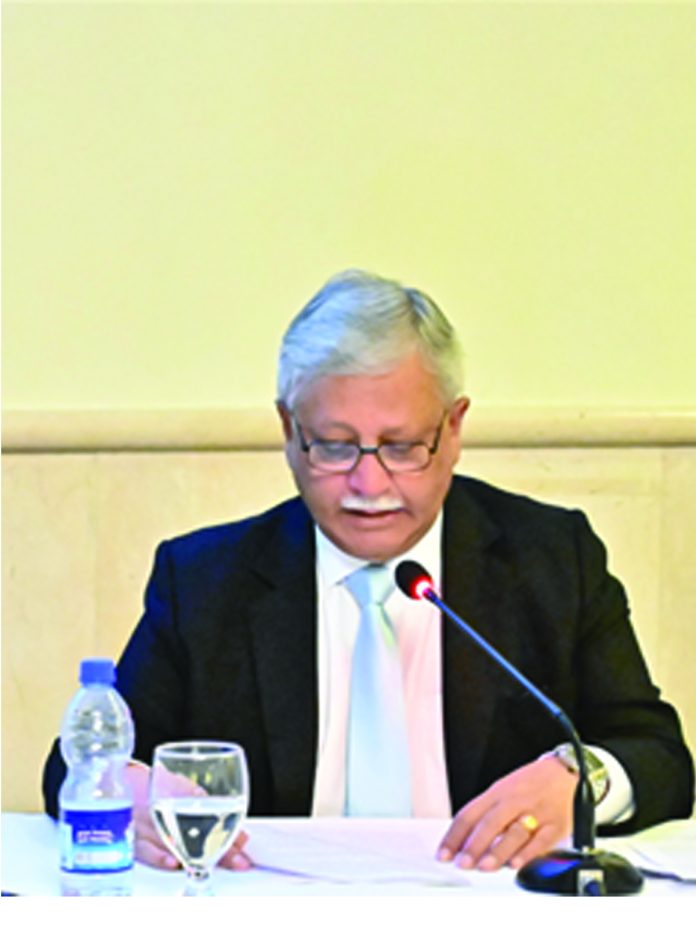NOTE: In celebration of seventy years since the Bandung Conference, the Pakistan Institute of International Affairs (PIIA) hosted a series of significant sessions, among which “Cutting Edge Technologies” held special prominence. Chaired by Lt Gen (R) Khalid Ahmed Kidwai, Advisor Development, National Command Authority (AD NCA), the session featured a distinguished panel comprising Dr. M. Shaheer Waqar, President of 3D Group and AI and Cyber security Consultant; Dr. Hammad Mehmood Cheema, Project Director at the National Chip Design Centre, NUST; and Mr. John Mark Ochieng, Corporate Communications Officer at the Kenya Space Agency. The experts addressed three critical themes: the future impact of artificial intelligence, technological sovereignty, the geopolitical significance of microchips, and the dynamics of cooperation and rivalry in outer space. General Kidwai’s comprehensive and highly relevant remarks are presented here in full for the benefit of our readers.
Ladies and gentlemen. Assalam Alaikum and good afternoon.
It gives me immense pleasure to chair this parallel session on an important and one of today’s most relevant topics, that is, Cutting Edge Technologies. In the world that we live in today, there can be no two opinions on the reality that Technology is King. It has been for many decades of our modern world as we have grown up in, but in recent times, for at least the last one decade or so, cutting-edge technology in almost every sphere of our lives has moved and touched us at a breathtaking pace. In almost all aspects of human endeavor, technological advances, cutting edge technological advances, continue to lead and set trends, even life styles, to which modern life, nations, national policies, are expected to adjust and adopt, or else, lag behind competitors at the risk of losing out with consequences in a variety of fields ranging from multi-dimensional sectors of national security, economic advantages, developmental goals, GDPs, health, education, even travel and leisure, etc, etc. Most of these technologies cannot be confined in straight jackets. These have cross applications in a variety of our everyday lives. While some may be more relevant to civil applications, the same may also be relevant to military applications, and vice versa. Cutting-edge technologies rule the roost in today’s world, and nations had better keep abreast.
Today’s session has three eminent speakers and experts in their respective fields. They will dwell on different aspects and areas of cutting-edge technologies and enlighten us in areas of their expertise.
Dr Shaheer Waqar, President 3D Group, and AI and Cyber Security Consultant, Islamabad, will be speaking on the Impact of Artificial Intelligence in the Future, even though AI, as we know it and as it unfolds its daily and weekly wonders, has been around for some time. It will take some crystal ball gazing on the part of Dr Waqar to tell us about the impact of AI in the future. With his expertise and wide mastery over the subject, one looks forward to his views with great interest.
The second speaker is Dr Hammad Mehmood Cheema, Project Director, National Chip Design Centre, National University of Science and Technology (NUST), Islamabad. His topic is Technological Sovereignty: How Microchips Became the New Oil in Geopolitical Rivalries. As a Director of the relevant subject at Pakistan’s prestigious University NUST, Dr Hammad is eminently qualified to tell us about the criticality of the wonder technology of microchips, which are the heart and soul of all modern technologies. Indeed, I might venture to say that in many ways, microchips are central to the ongoing trade war between the US and China because these are at the core of most cutting edge technologies imbedded whether in AI, robotics, cyber warfare, drones, hypersonic missiles, space technologies, communications, energy applications, and in a variety of civil and military applications. No wonder that the sponsors of the conference have considered it apt to refer to microchips as the new oil relevant to technological sovereignty and geo-political rivalries. I am reminded of a slogan that became popular in India sometime in 1994 when fast food chains first appeared on the scene in Indian life with their burgers and French fries, as against the dearth of investments in hardcore technologies. The popular slogan of the protestors coined by the BJP supporters was “Microchips yes, potato chips no”. In many ways, the slogan gave a fillip and strength to what is now a very large IT industry in India. Today, for India, microchips are certainly the new oil and facilitate India’s technological sovereignty. So I will say to Dr Hammad, microchips, yes, please tell us more about this new oil in geo-political rivalries.
The third speaker of this session is Mr. John Mark Ochieng, Communications Officer, Kenya Space Agency in Nairobi. His topic is “What Cooperation and Rivalry in Outer Space Mean for the Future of Space Exploration”. The topic is current and relates to the race for scientific, strategic, and military advantage in outer space by some of the leading space-faring nations of the world. The select group includes Pakistan’s closest friend, China, as well as the closest geo-political rival, India, both of which have moved into space by leaps and bounds despite being relatively late starters. Pakistan lagged behind in this area because of a lack of direction and government support, even though Pakistan’s space agency, SUPARCO, was established in 1961, and India’s space agency, ISRO, was established in 1969. It was only since 2001, after four wasted decades, when SUPARCO was taken over by the Strategic Plans Division SPD that SUPARCO was put through a rigorous rejuvenation and reorganizing process. It was given clear-cut strategic direction and objectives, and adequate funding to deliver on the objectives. It took time, but resultantly, SUPARCO is today a vibrant organization and has placed a number of Communications and Remote Sensing Satellites in space with the assistance of China. It is now gearing up to send a manned mission to the Chinese Space Lab next year to conduct scientific experiments.
Ladies and gentlemen. As you can see, the spread between the three speakers and their respective topics on various aspects of cutting-edge technologies, there is a rich blend of some of the most current and relevant technologies that this session will be presenting to you.
Before I request our speakers to take the floor for their respective topics, I, as the fourth member of the panel, would like to express my thoughts as well on the subject of cutting-edge technologies. Also, because I happen to be the sole military man on this panel, my views would cover the effects of cutting-edge technologies on the military and on warfare as I see these.
Cutting-edge technologies, or emerging technologies as these are fashionably being referred to nowadays, is a vast spectrum that is not only important but is also simultaneously both current as well as futuristic. Current because some of these technologies have been operationalized and are with us, and futuristic because some others are in the process of being tested and will be operationalized in due course of time for civil and military applications.
In principle, I would say that all technologies, including emerging technologies that are employed for military purposes, generate a profound effect on the development of weapons and on war-fighting tactics and strategies. These also include the three technologies that our speakers will be discussing later: Artificial Intelligence, Microchips, and Space technologies. By implication, therefore, the effects so generated impact the maintenance of military and strategic balance between adversaries in a conflict region. And because strategic balance between adversaries is a guarantor of regional peace, as indeed strategic imbalance is an invitation to aggression and breakdown of peace, one can safely conclude that emerging technologies based on cutting edge technologies are directly linked to the preservation of peace between two or more adversaries through the generation of strategic deterrence effects of technologies.
In the context of our region of South Asia, which is between India and Pakistan, any strategic imbalance induced through the induction of these technologies for military purposes by India would most certainly affect deterrence stability in South Asia. Therefore for Pakistan particularly it is imperative to ensure that it does not allow such strategic imbalances to be induced that will negatively affect the delicate strategic balance that Pakistan has worked so hard to establish through the acquisition of a robust nuclear weapons capability as The Great Equalizer in an operational environment of relative conventional asymmetry in selected areas of conventional forces.
Some of the emerging technologies have been around for quite some time now, and are relevant and vital particularly to the security environments of countries like Pakistan which are located in international crush zones and have to bear the brunt of the cross currents of international geo-political power play, east-west, north-south as these play out in our region even as I speak.
In addition to the interplay of the cross currents of international geo-political power play, Pakistan continues to bear the strategic consequences of the unfinished agenda of the partition of India, with the unresolved conflict over Kashmir with its eastern neighbour. Therefore for Pakistan’s national security dynamics, and strategic stability in South Asia, the geopolitical challenges translate into a variety of threat scenarios, ranging from the good old fashioned contact warfare to non-contact warfare like Hybrid war, 5th Generation war, and the evolving notions of national security ranging from the traditional to the non-traditional, all of which must be taken into account by Pakistan’s national and strategic planners.
It will be relevant for me here to mention or anticipate with reference to the latest episode of the killing of 28 people in Pahalgam in Indian Illegally Occupied Jammu and Kashmir that both India and Pakistan, while planning their respective operational responses and counter responses for the near future, will take into account the deterrence effects of the respective nuclear arsenals as well as of the operationalized technologies in the respective inventories. Both capabilities will exercise a profound influence on the response options and decision-making available to each side.
In this complex mix, we can also add the emergence of exotic and new technologies, as these evolve and unfold year after year, not only globally, but more importantly, from Pakistan’s perspective in our region of South Asia. If you have been following closely the two raging wars of our current times, the war in Ukraine, and the one-sided genocidal war in Gaza, and now, recently the melt down in Syria, followed by Israel’s relentless bombing out of Syria’s residual military capability, many of these technologies along with their novel, lethal, and devastating results, are on full display like a science fiction movie, for us professionals to marvel and take home lessons with relevance to our respective professional assessments, and application where necessary in our own strategic and operational environments, and in our own war preparedness.
The study of the effects that are being generated by the new and emerging technologies in different domains and from different perspectives can be looked at from two interlinked prisms. One, the role or blend of emerging technologies in comprehensive national security broadly, and two, the strategic effects or implications of emerging technologies on Strategic Stability or Deterrence Stability in South Asia, which, of course, is of immediate and direct concern to us in Pakistan in the aftermath of the Pahalgam Episode. In my opinion, there is an obvious connectivity between the two prisms or perspectives.
I would also like to take a somewhat philosophical and historical view of the term Emerging Technologies. The term Emerging Technologies, in recent years, has caught the imagination and attention of today’s military professionals as something of a new and exotic term of our times. Perhaps because exotic technologies like Artificial Intelligence (AI), hypersonic weapons, suicide drones, reconnaissance and armed but invisible drones, directed energy weapons, cyber warfare, robotics, space capabilities, and potential space warfare, etc., conjure up a vision of a Star Wars-like inter-galactic warfare from unknown faraway distances. In this faceless warfare, the adversary can neither be seen nor pinpointed for possible retribution and retaliation.
A video-game like environment where an anonymous individual, not necessarily our traditional professional soldier, perhaps, for all you know, a hired mercenary, a part time college going kid, sitting in Miami Florida casually playing on a video-screen in a corner of the CENTCOM operations room, who can blow up with mind boggling precision Ayman Al Zwahiri in the balcony of a Kabul apartment.
Or a faceless cyber space hacking operation which can switch off the electricity grid of a mega city thousands of miles away on a different continent, plunging modern life into chaos and panic besides inflicting massive financial losses.
Or a few computer whiz kids sitting in an insignificant operations room in Tel Aviv conducting strategically lethal and precision strikes on a wanted adversary like Ismail Haniyeh Shaheed, generating the effects of a decapitating strike.
Or the recently conducted deadly strikes on Dnipro and other strategically sensitive targets in Ukraine by the Russian hypersonic Oshernik Missiles with speeds of over 10 Machs, which simply cannot be intercepted by any known NATO air defence system.
The effects generated through some of these technologies therefore include shock and awe, surprise, and destruction far in excess of conventional technologies as we have known them – force multipliers in any way you look. This, ladies and gentlemen, is warfare without a nametag. This is not the future; this is here and now, as I said, on full display on the international screen of the two current wars; notions of traditional deterrence stability being blown away because of a one-sided acquisition of a capability made possible by emerging technologies, I’ll repeat for emphasis, notions of traditional deterrence stability being blown away because of a one sided acquisition of a capability made possible by emerging technologies; and for added emphasis, please note, one-sided acquisition. It is true for Europe, it is true for Trans-Atlantic, and Trans-Pacific; how then can it not be true for South Asia?
But before you get too alarmed, let me put things in a philosophical perspective to calm nerves. Of course, we all seem to have latched on to this relatively new term or coinage of emerging technologies with much enthusiasm, awe and novelty as if the development and emergence of technologies before our current era had come to a stop and that it is only of late that technologies have made a breakthrough and started to emerge or re-emerge from hibernation.
Philosophically speaking, if we look at technologies in a historical perspective, I would like to submit that for ages past, and for that matter for centuries past, technologies and technological developments in any given era, were always dynamic, progressive and generated profound strategic effects on the strategic stability-instability paradigm in that particular era, time, place and region. Of course with each passing decade, or a couple of decades, or a century, the complexity and lethality of technologies certainly became more and more challenging in each era than in the eras past but because science and technology are by their very nature progressive, innovative and a marvel, new technologies did not really stop emerging – ever. Technologies remain in an unstoppable race to ever-expanding frontiers of excellence, innovation, capabilities, and mysteries. It is impossible to tell where and when these would stop, if ever.
Today, if we were to look into the future, say ten, twenty or thirty years from now, I would venture to say confidently that the emerging technologies of today which we find so fascinating and absolutely up there in the order of scientific and engineering excellence, and therefore, perhaps creating strategic instabilities, will surely be overtaken by even greater and more and more innovative developmental marvels of technologies; it is in the nature of the beast; science and technology. One might even agree that today’s emerging technologies that we are viewing and debating with such awe will probably pale into lesser significance when the scientists of the future would outdo themselves in inventing even more exotic technologies in a couple of years and decades from now.
But as surely as night follows the day, the flip side constant of the history of military technologies is that strategists, antagonists, scientists and engineers in each era have invariably found antidotes and effective counters to the emerging technologies of their respective times. While many inventions initially developed for civil applications found their way into military applications, the fact is that, in line with Newton’s 3rd Law of Motion, for every action there was invariably an equal and opposite reaction. Thus we find in military history that whether it was the then emerging technologies of archery, horse cavalry, artillery, a fighter airplane, a tank, a missile, a submarine, means of communications, lasers, satellites, or even a nuclear weapon, science and technology invariably provided near-simultaneously a counter to the particular emerging technology of the day. It is also a historical reality that all of these technological developments at different times in history did indeed lead to destabilizing the then prevailing strategic or deterrence stability order for a while, but only up to such time until a counter technology or antidote re-established strategic and deterrence stability.
What follows from that past historical perspective, therefore, is that the current and upcoming technologies that we today are referring to as cutting edge or emerging technologies would surely soon enough find their counter and antidote through timely scientific human endeavor. It is only a matter of time. Strategic stability, politically and militarily speaking, wherever disturbed, will soon then be re-established. That, in my opinion, is a recorded lesson of history in the interplay of the forces of science and technology and deterrence stability.
In this context, I would like to briefly give examples from the short history of 75 years in South Asia, that is, India and Pakistan, and recall the strategic effects of the then-emerging technologies on strategic stability in South Asia, which were generated at various times. The inductions in Pakistan’s military of the then state of the art technologies in the form of F-86 Sabre jets, the F-104 Star fighters, the varieties of Mirages, MIGs, F-16s, and now in India of the Rafale fighter aircraft, the S-400 Anti-Ballistic Missile (ABM) system, the Beyond Visual Range (BVR) missiles, the various versions of US and Soviet built tanks and artillery, culminating in the development of nuclear weapons in South Asia, confirmed through the conduct of nuclear tests in May 1998.
Add to this the long inventory of delivery systems comprising of a variety of ballistic and cruise missiles. All of these are examples of new or emerging technologies that arrived at a certain point in time on the South Asian strategic scene, played their due role in destabilizing the then prevailing strategic stability paradigm in South Asia, for a while, till the other side did catching up, found an antidote of an equal and opposite technology only to restore the disturbed strategic balance sooner rather than later.
It is only logical therefore to expect that with the availability of ever evolving exotic technologies for the purposes of deterrence, or for furthering military advantage against perceived adversaries, or for fighting wars, strategists and practitioners of war will continue to make adjustments and introduce innovation in deterrence strategies, war fighting techniques, tactics, doctrines, and strategies, what you will.
As has happened so often in the past, some of the technologies developed for civil applications with the good of humanity at heart will continue to be adopted, wherever possible, to serve the purposes of new types of warfare, kinetic or non-kinetic. The phenomenon also works the other way around, where strategists and practitioners of warfare will continue to demand that a certain type or category of technology be developed by scientists and engineers through focused R&D to meet the ends of strategies. And so the cycle continues. The cooperative and corporate interests of governments, the military-industrial complexes, the military strategists and practitioners, the think tanks, and scientists and engineers of various shades perpetuate a common professional and vested interest.
I think I will stop here. If there are still some gaps in my presentation, I will be very happy to tackle these in the Q&A session.







